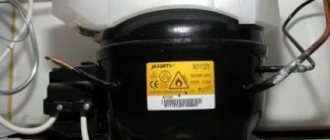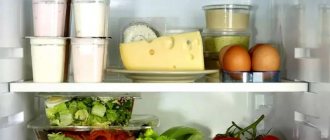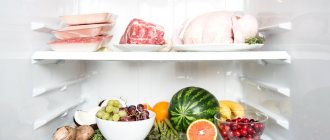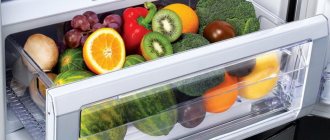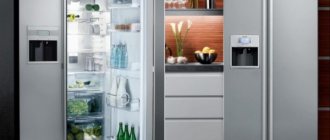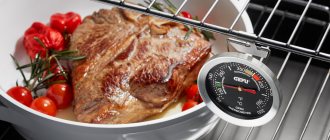Installation and connection
Before placing the unit, you need to read the instructions, which contain some requirements for the installation location:
- the air gap between the rear and side walls of the housing and the partition of the kitchen unit (built-in appliances) or the wall (free-standing unit) must be at least 5 cm;
- the distance from the floor to the bottom of the freezer is 5-8 cm (adjustable by twisting the legs). In the same way, use a level to prevent the device from skewing;
- installation under the hob is prohibited;
- place the unit at a distance of at least 30-50 cm from the radiator, gas stove and other heating devices;
- the room temperature must correspond to the climate class of the unit;
- Avoid exposure of refrigeration equipment to direct sunlight.
Before connecting to the power supply, make sure that the voltage of the network and the freezer correspond. If there is no grounding in the outlet, contact a specialist, otherwise the manufacturer will not be responsible for the consequences.
The first connection of the unit is carried out after 6 hours of its stay at room temperature. Pre-wipe the inner surface with warm water with vinegar or a soda solution. This will help eliminate the unpleasant smell of new equipment. Remove any remaining moisture with a clean, dry cloth.
Optimal temperature in the refrigerator compartment
Next, we will sort out all the nuances, but we will immediately say that based on the data below, you can easily determine what temperature should be in the refrigerator so that it is suitable for all (most) types of products.
The temperature in the refrigerator should be between 2 and 4 degrees Celsius.
But wait, don't go! A lot depends on the foods that are most often stored in your refrigerator and the actual cold distribution!
Most manufacturers of refrigeration equipment for domestic use indicate that the optimal temperature for the freezer is -18 degrees Celsius. As a rule, this indicator is the standard operating mode of most modern freezers.
Despite this, in some situations it makes sense to deviate more or less. To determine the optimal temperature for your freezer, pay attention to the following important points.
The key factor when choosing the appropriate temperature setting for the freezer is the amount of food stored in it:
- If the compartment is less than half full, -12˚С…-14˚С is sufficient for freezing and long-term preservation of food. This will allow you to reduce the amount of electricity consumption without causing melting and spoilage of meat or berries.
- If most of the shelves in the freezer are filled, and the bulk of the products in it are meat products, the optimal temperature range will be -18˚С…-24˚С. In such conditions, products will be stored for several months without losing their quality.
- If you need to quickly freeze berries, fruits or other products, you should set the fast freezing mode, which corresponds to a temperature of -24...-30 degrees Celsius. The same mode should be set when turning on the freezer for the first time before loading food into it.
A change in temperature even by a few degrees can cause not only a deterioration in the taste of frozen foods and the loss of some nutrients, but also a decrease in shelf life. For example, at a temperature of -18 degrees Celsius, meat is stored for about 6 months, and when the indicator increases to -12, the duration of its suitability for consumption is reduced to one week. The shelf life of fish varies from a week to several months depending on the indicators.
For this reason, when setting the freezer mode, it is necessary to take into account the temperature ranges recommended by food product manufacturers.
Let's list the duration of storage of some food products in the freezer depending on the set temperature.
Manufacturers recommend setting the temperature in the refrigerator from 2 to 5 degrees.
Many devices automatically set it, but users have the opportunity to change these settings. An amplitude of 3 degrees is critical for some food products, so great attention should be paid to storage rules.
- Check the functionality of the device.
- When you need to check whether the selected mode is suitable for those products that are stored.
- To check if it is cold enough to meet shelf life.
| Product | Temperature | Shelf life |
| Fresh meat | 1 – 3 | 36 hours |
| Fresh seafood and fish | 0 – 2 | 48 hours |
| Eggs | 2 – 5 | 1 month |
| Ready food | 2 – 5 | 5 days |
| Vegetables | 4 – 7 | 30 days |
| Dairy | 4 | depends on the type of product |
| Fruits | 5 – 8 | 10 days |
| Bread | 5 | 3 days |
| Confectionery | 1 – 3 | 4 days |
| Mayonnaise, ketchup, other sauces | 3 — 7 | 4 months |
Expert opinion
Torsunov Pavel Maksimovich
Therefore, it is necessary to consider what exactly is in the refrigerator to determine the optimal temperature.
You also need to take into account exactly how the cold flows are distributed in the chamber. If the MultiFlow function is available, the air is distributed evenly, including in the freshness zone. However, in its absence, it is coldest at the far wall.
It’s worth considering what the temperature regime will look like if you set everything to 4:
- If the freezer is located at the bottom, then it will be about 3 degrees. It is recommended to store fish, meat and other perishable foods here. It is believed that this is the coldest place. The closer to the back wall, the colder it is, since the refrigerant is located there.
- On the middle shelves the temperature is from 3 to 5 degrees. It is recommended to store dairy products, fruits, bread and various cuts on them.
- The door shelves are the warmest place if there is no MultiFlow function. There may be 5 – 10 degrees. Thus, it is worth storing ketchup, mayonnaise, drinks and anything else that can be kept at such high temperatures for a long time.
- The freshness zone is for vegetables. It has its own microclimate, which is slightly different from the climate in other areas of the refrigeration chamber, and the temperature does not exceed 8 degrees.
The absence of the MultiFlow function does not allow you to get the same indicators. It is necessary to take this into account and arrange food items correctly to extend their shelf life. If this function is present, then additional fans distribute the air evenly, so the temperature in the entire chamber is almost the same.
Food lasts longer in the freezer.
- If there are few products, then -14 degrees is enough.
- When filling over 50%, you need to set from -20 to -24 degrees.
- Rapid freezing occurs at -30 degrees.
You also need to consider the power of the freezer. It is indicated in the technical specifications and allows you to understand how quickly the placed products are cooled. The lower the temperature, the longer food can be stored.
You can determine the correctly selected mode visually. To do this, you need to look at the containers stored inside: if there is a slight layer of frost on them, then this is normal. A large layer of snow indicates that you can reduce power.
Food that has been removed from the freezer and has begun to thaw cannot be re-frozen. They need to be completely used or transferred to the refrigerator.
An icy surface and a coat of snow indicate the presence of incorrect settings or problems with the device, which may include:
- Automatic resetting of parameters towards greater cooling.
- Condensation cannot escape due to the filled drain hole.
- Thermal sensor malfunction.
- Problems with the heating element or electronic unit.
Expert opinion
Torsunov Pavel Maksimovich
It is recommended to solve all these problems with the help of a specialist.
Optimum temperature of the refrigerator compartment
In the refrigerator compartment, the average operating temperature will be different in different areas. As a rule, the following indicators will be observed:
- In the freshness zone: 0… +1 degrees. This zone is not found in all refrigerators, but is represented by such popular manufacturers as LG and some others. It is designed for storing meat, fish and other perishable products (they can be kept here for 3 days). As a rule, in modern refrigerators such a zone is located at the top of the refrigerator compartment.
Important: you should take into account the specific temperature conditions of the presented zones when organizing food storage in your refrigerator. Otherwise, you will regularly encounter the fact that some products very quickly lose their properties and freeze (for example, fruits stored for a long time in the freshness zone), while others, on the contrary, spoil (for example, improperly laid out meat).
Impact of ambient temperature on freezer operation
In winter, the temperature in an unheated room drops below 10 0C. Placing the unit in such conditions will lead to its breakdown or complete failure. In this case, loggias and balconies are divided into 3 types:
- Open. They are characterized by low temperatures in winter and lack of protection from the sun and precipitation even in summer. This arrangement of the freezer risks a short circuit, deformation of the seal, corrosion of metal elements, malfunction of the control board, and cracking of the coating. In units with the No Frost function, the evaporator is covered with ice.
- Glazed, but not equipped with additional insulation. The temperature in such a room will be slightly higher than outside. If the frost does not exceed 15 0C, then the unit will start, but operation in such conditions will lead to a significant increase in the load on the compressor. At low temperatures, oil quickly thickens; when the refrigerant leaves the condenser, the pressure drops, which causes the engine to idle and quickly break down.
- Closed and insulated. Additional thermal insulation of the walls will ensure temperature stability on the balcony or loggia. Usually its indicators reach the temperature level in heated rooms. Another advantage of operation is the absence of negative effects of precipitation. If you want to install the unit in such a place, provide protection from sunlight and high-quality ventilation, which will prevent overheating of the unit and the formation of condensation.
We suggest you familiarize yourself with the temperature in the freezer of a Bosch refrigerator
When purchasing a unit for an unheated room, it is advised to pay attention not only to the climate class of the equipment, but also to its design features. The ideal option would be to purchase a chest freezer that has a horizontal orientation. Some models are produced with the function of operating at a temperature of -15 0C.
Class N freezers operate at air temperatures of 16 - 32 0C, SN - from 10 to 32 0C, ST - from 18 to 38 0C, T - from 18 to 43 0C. The instructions indicate that turning them on at sub-zero temperatures will lead to technical failures in the functioning of the elements or complete failure of the unit.
At the same time, Liebherr has released a number of models of freezers with climate class SN-T, which are equipped with a function that allows the device to operate at temperatures as low as -15 0C. You can check whether the unit has such a feature by its serial number, which starts with 48.906.751.8.
The principle of operation of the device is identical to the algorithm of the refrigerator. The refrigerant at low pressure is heated in the evaporator and turns into gaseous form. In this case, it absorbs heat from the internal space of the chamber.
Then the compressor, against the background of increasing pressure, sucks in the refrigerant, forcing its vapor into the condenser. Freon passes into the liquid phase and releases heat to the environment. Entering the filter drier and capillary tube, it enters the evaporator. When the freezer temperature rises to the set point, the cycle repeats.
The equipment of this brand is easy to operate. According to the instructions, the units must be placed in a room with a humidity not exceeding 75% and a temperature corresponding to the specified climate class of the selected model. The rated voltage of the electrical network is 220-230 V. Operation under other conditions may cause damage to the freezer. Service life – 10 years.
Depending on the model of the device, the capacity of the freezer is 4-8 kg/day. If you need to freeze a larger volume of food, remove the baskets and set the “Freezing” mode, which is indicated on the temperature regulator with the number 7. Turn it on 24 hours before filling the chamber, and 24 hours after loading it, move the relay knob to the normal position.
To ensure air circulation, place fresh food at a short distance from each other. They must not protrude beyond the edge of the evaporator shelf or beyond the load limit lines (if any) that are marked on the inside side surface of the chamber. Use foil, plastic bags or plastic containers as packaging material.
Atlant freezers not equipped with a No Frost system must be defrosted periodically. When a snow cover of 5-7 mm thick forms on the inner surface, perform the following steps:
- disconnect the device from the network;
- remove all products and components;
- leave the door open;
- Remove melt water using a moisture-absorbing cloth or napkin;
- Rinse the freezer with warm water and dry.
When connecting the unit to the network, set the regulator to the maximum value. After 2 hours, load the food and turn the thermostat knob to position 3.
Does refrigeration equipment operate at sub-zero temperatures?
Is it possible to install and operate a refrigerator on the balcony in winter?
Making your own freezer
When using a freezer, you may encounter the following features:
- Inability to open a door that has just been closed. Wait 1-3 minutes for the pressure inside the chamber to equal the outside pressure.
- Additional noise. Check the correct placement of the device, its internal components and external elements, the contact of which contributes to the appearance of extraneous sounds.
- Shrinkage of thermal insulation material (polyurethane foam). The irregularities that form on the surface of the freezer do not affect its operation.
Other problems that arise during operation of the device require calling a technician and carrying out repairs.
Let's look at the operating features and technical characteristics of this brand's device using the example of the BD(W)-4250x model. The unit is a chest freezer operating at a temperature of 10-32 0C.
The temperature inside the freezer is set by placing the thermostat knob in the desired position:
- 1-3 – from -10.5 to – 16.5 0С;
- 4-5 – from -14.5 to 21.5 0С;
- 6 – from -21.5 to -24 0С;
- 7 – deep freezing.
When loading food into the chest, the distance to its edge must be at least 12 cm. Leaving liquid food in glass containers or drinks in cans or glass bottles inside the unit is prohibited. I also do not recommend putting warm and hot foods in the freezer.
Otherwise, the operating rules for Kraft brand freezers do not differ from the requirements specified in the instructions for such units.
Some models have a Super Frost function, which allows you to lower the temperature inside the chamber to -38 0C.
As for the freezer, here you need to proceed from how intensively (densely) it is packed.
If your freezer usually doesn’t have a lot of food and you don’t use it too often, then you shouldn’t set the temperature above -14 degrees.
In the case when the freezer is used frequently, more than half is loaded, and the majority of the products are meat, then it would not be a bad idea to reduce the temperature to -20 -24 degrees.
The optimal temperature that should be in the freezer is -18 degrees.
The “Quick Freeze” or “Super Freeze” option is used to quickly freeze fresh food. As a rule, this occurs at -24 -30 degrees for several hours.
It is believed that this process makes it possible to better preserve the taste of vegetables, berries, and herbs.
The manufacturer's line includes single-chamber freezer cabinets, and those included in the general complex, two-chamber cabinets with a refrigeration cabinet. In each case, the instructions describe exactly how to adjust the temperature in the Atlant refrigerator of each model. To adjust, use the control button for adjusting the mode in the refrigerator compartment or a rotary wheel with graduation. What temperature in a particular refrigerator compartment can be measured with a thermometer and make sure that the regulator corresponds to the actual position.
It must be remembered that setting the temperature in a two-chamber Atlant refrigerator with one compressor is a parameter that allows you to regulate only a complex decrease or increase in temperature in the entire system. How to set the indicator correctly depends on the load on the cameras. The most economical mode of operation of the device is if it is loaded to 2/3 of the volume.
If a problem arises, the refrigerator freezes, most likely the temperature relay sensor needs to be replaced. During normal operation of the thermostat, the temperature in the refrigerator compartment will not drop to minus.
In a two-compartment refrigerator with one compressor, a common refrigeration circuit is created for the freezing and cooling zones. Changing the settings of one of them will introduce an imbalance in the system. Therefore, the instructions for the temperature mode in the Atlant two-chamber refrigerator provide for changing the level with one manual regulator, with graduation points 1-7.
Instructions for setting the temperature in the Atlant refrigerator indicate exactly where the temperature regulator is located. The manufacturer warns that increased cooling of the chambers in modes 5-7 may result in compressor failure due to overheating during continuous operation. It is necessary, after freezing the food, to return to the normal position (2-4) on the temperature regulator in the Atlant refrigerator. How to set and adjust the position of the wheel can be seen in the photo when using two compressors.
We suggest that you familiarize yourself with the temperature in the refrigerator should be according to sanpin
Atlant refrigerators of the “new wave” series are available with a display and electronic control. A control button with parameters displayed on the display allows you to set the temperature, adjusting it with an accuracy of 1 degree for the refrigerator and freezer independently.
cooling chamber
The temperature in the refrigerator fluctuates depending on the location of a particular zone. Standard range is from 0 to +8 ℃.
As a rule, there are 4 main zones in the refrigerator (both in modern models and in older devices). Let's take a closer look.
Freshness zone
Freshness zone (or zero zone) - this compartment has the lowest temperature readings: from 0 to +1 ℃. In single-chamber refrigerators, the zero zone is located directly next to the freezer compartment (above or below it); in two-chamber units, it can be located either near the freezer or in the middle of the refrigerator compartment, representing a separate closed shelf. Often, it is in the freshness zone that the temperature regulator is located and the air supply openings are located. Read the instructions for your model.
In this zone it is recommended to store: meat, fish, fresh seafood, semi-finished products, sausages, cheeses, fruits (with the exception of some exotic ones) and confectionery (cream).
The freshness zone allows you to quickly cool champagne and spirits. It is better not to keep beer and juices in this area; the temperature for storing them is slightly higher
Middle shelves
The next compartment is the middle shelves of the refrigerator. Here the temperature is +2…+4 ℃. They are suitable for storing meat and dairy products, slices, eggs, and baked goods.
Then, closer to the lower drawers, there is an area for storing ready-made food: soups, main courses, salads, canned food and pickles. This is usually the largest shelf, where pots and three-liter jars can easily fit. The temperature in the refrigerator here reaches +5…+7 ℃.
The temperature in the refrigerator, in the area of the lower drawers and shelves on the door, is +6…+8 ℃. It is recommended to store some fruits and vegetables, sauces (ketchup, mustard, etc.) and drinks here.
Thus, the optimal temperature in the refrigerator varies from point to point and is, on average, +3…+5 ℃. If the refrigerator door is closed during the day, the temperature gradually equalizes. Certain zones maintain their own microclimate.
If your unit does not have an electronic display, you can measure the temperature in the refrigerator and freezer with a regular outdoor thermometer. Just put it in the refrigerator for 12 hours
Video review: temperature distribution in the refrigerator and why food can spoil
Here is a table with recommended refrigerator temperatures for the most common foods.
| Product | Temperature | Shelf life |
| Meat (fresh) | 1 3 | up to 36 hours |
| Fish and seafood (fresh) | 0 2 | up to 48 hours |
| Eggs | 2 5 | Max. 4 weeks |
| Ready meals | 2 5 | up to 5 days |
| Vegetables | 4 7 | from 5 to 30 days |
| Milk | optimal 4 | different |
| Fruits | 5 8 (except exotic) | Many housewives know that, for example, it is better not to store bananas in the refrigerator, because... they may turn black there due to too low a temperature. The same goes for mangoes, passion fruits, pineapples and others. |
| Bread | 5 | up to 3 days |
| Confectionery with cream | 1 3 | up to 72 hours |
| Ketchups, mayonnaise, sauces | 3 7 | from 15 to 120 days |
In any case, we recommend double-checking the indicated expiration dates for each product on its packaging.
Devices from various manufacturers have two storage chambers: a freezer and a refrigerator.
Each of these chambers is designed to perform its own functions: cooling and freezing. Therefore, the optimal temperature in the refrigerator and freezer will be different.
Freezer
The temperature range in the freezers of different refrigerators ranges from -6⁰ to -25⁰С (a deviation of a couple of degrees is possible). Many manufacturers indicate the lowest possible freezing rate in their operating instructions. But you can determine it without resorting to the instructions: the temperature in the refrigerator’s freezer is indicated either on the device’s settings panel, or is indicated in the form of snowflakes, each of which determines -6⁰C.
Cooling chamber
This compartment is designed for storing food in a refrigerated state. Since different products “require” different conditions to prolong freshness, they must be stored systematically in the refrigerator:
- The highest temperature is distributed on the shelves of the device door, so it is better to fill them with drinks and various sauces;
- The lowest temperature of the refrigerator is distributed along the upper shelves, closer to the rear walls. In such a place, chilled meat, milk, and fish retain their freshness longer and better;
- The normal temperature in the refrigerator is on the middle shelves. The average indicator was noted there: 3–5⁰С. This is an ideal place to store sausages, cheeses, sweets and kefir;
- On the lower shelves, which are installed near the boxes for vegetables and fruits, the indicator is no more than 8⁰. In such conditions, soups, main courses, and salads will be stored longer.
The temperature in the refrigerator also depends on how often the door is opened. Actually, this also affects such a spread in the refrigerating chamber.
In modern models of appliances, such as LG, Samsung or BOSH, manufacturers have installed a separate section called the “freshness zone”, in which the temperature is always constant (1⁰C), regardless of the frequency of use of the refrigerator. Meat in such a zone retains its freshness for 3 days.
Freezer
Depending on the refrigerator model, t˚С in this compartment can range from -6 to -25˚ Celsius. The lowest temperature in the refrigerator freezer is used only for blast freezing. The optimal temperature is taken at -18 ˚С. This is exactly how many degrees the vast majority of manufacturers suggest setting in freezers.
The temperature setting in the freezer depends on what exactly is stored there. Determining the lowest possible temperature of the unit is very simple. Almost every refrigerator has snowflakes or stars painted on the temperature control panel or somewhere else. Each of them means a range of 6 degrees. By counting the number of snowflakes, you can determine the lowest temperature that your refrigerator can maintain.
Freshness zone
Such a compartment is not present in every refrigerator. Its presence is an advantage of newer models. The freshness zone is a special place in the general cooling chamber. The temperature there is maintained close to zero. This is the optimal temperature in the refrigerator, at which the development of various microorganisms is significantly inhibited. This means that the products last much longer.
There are 2 types of arrangement of the “Fresh Zone”:
- Leaky drawer.
- A separate insulated chamber in which a certain temperature and humidity are independently maintained. In this case, the “Fresh Zone” is most often divided into two more compartments. One of them maintains humidity at about 55%, and the other at 95%. The first is used to store fish, and the second - vegetables.
The temperature in both compartments is set at 0… 1˚С. At this temperature, food products are not completely frozen and retain their beneficial properties best.
The “Fresh Zone” usually stores:
- fish, meat, semi-finished meat products (no more than a week);
- sausages;
- cheeses;
- any dairy products, except cottage cheese;
- vegetables and fruits, except tomatoes and bananas;
- greenery.
This refrigerator compartment can also be used to quickly cool alcoholic and non-alcoholic drinks. But beer and kvass and natural juices should not be placed there. They require a higher storage temperature.
Other compartments
Pay attention to the top shelves, as well as the closest compartment to the “Fresh Zone”. The temperature regime in this part of the refrigerator chamber is maintained in the range from 2... 4 °C. On these shelves you can place eggs, pastries and cakes, semi-finished products, and dairy products. Meat and fish can be left here for no more than 36 hours.
Middle shelf. Here the normal temperature ranges from 3 to 6 degrees Celsius. This part of the refrigerator is best for storing soups, sauces, ready meals and other foods.
Bottom shelf and vegetable compartment. According to standards, correctly set t˚ in this compartment cannot exceed 8 °C. However, in practice it is usually 6 °C. You can place as many products as you like here that you do not intend to store for a long time.
Instructions on how to set the temperature
Automatic control of content cooling is carried out by periodic compressor starts. Methods for adjusting the temperature in Atlant refrigerators depend on the design of the model: whether the unit operates simultaneously with a common chamber and a freezer, or whether the device is a two-compressor unit. In both cases, the cold is adjusted using a mechanical or electronic regulator. The first method involves operating a rotary switch; it is simple and reliable, typical of inexpensive models. In another case, the device is equipped with an electronic display and a temperature relay.
Mechanical regulator
It is a video with digital risks from 1 to 7: with increasing values, the cold intensifies. A two-chamber unit may have more than 1 regulators. When the compressor is in unit 1, the cooling circuit for both cavities is common, and there is only one roller. You can see the temperature regulator in the Atlant refrigerator when the door is open at the top of the device. The setup procedure is as follows:
- Switching on the device for the first time. Set the switch to position 2 - there will be a locking click.
- Decreasing degrees is a translation by a certain number of divisions. The compressor will work continuously if you set modes 5-7. This mark is used when quick freezing is needed. Warning from the device manufacturer: prolonged operation in this mode may result in compressor failure due to overheating.
- Transition from intensive cooling to standard. The operating range is indicated by positions 2-4, which corresponds to +1...+5ºС in the refrigerator compartment and -18ºС in the freezer.
View » What should be and how to adjust the temperature in the LG refrigerator and freezer
Before adjusting the two-compressor Atlant, you need to make sure that the model has 2 cooling circuits. That is, each camera has its own adjustment roller. The operations are no different from those for setting the temperature regime of a refrigerator with 1 compressor. Knowing how to set up the device is also useful because proper adjustment contributes to the rational use of electricity.
Electronic regulator
In many models of Atlant refrigerators, manual switches give way to modern settings methods. The devices are equipped with electronics - a control and display unit, where the temperature set in the chambers is reflected in numbers. The small display is located outside - no need to open the refrigerator. Read more about how to correctly set the cold level with an electronic regulator:
- changing the settings of the digital thermal relay is done by pressing push-button keys;
- installation is possible in the range -18…- 24ºС (what temperature should be in the freezer) or +2…+8ºС (for the refrigeration cavity);
- A single press of the key changes the set cooling mode by 1ºC.
How many degrees should be in each of the refrigerator compartments can be seen on the display. If the household appliance has two compressors, any of the chambers can be turned off; The digital display is divided into 2 zones, each of which reflects the state inside the device. The temperature is set by 2 adjustment blocks.
Optimal temperature in the refrigerator
The minimum temperature of the device ranges from -8 to -10 0C. The food placed in it will be stored longer than in the refrigerator compartment, but at the same time they will be frozen.
If you want to convert your freezer into a refrigerator, then on forums on the Internet they suggest following these steps:
- reconfigure the thermostat to a higher temperature;
- install a relay for the refrigerator.
At the same time, many argue that it will not be possible to make a refrigerator from a static freezer, but it is possible to convert units with the No Frost function, but unpackaged products will be severely weathered.
In the technical regulations applied in this area, there are certain standards that are applied by all manufacturers without exception. This means that the consumer is allowed to adjust the mode in both the freezer and the refrigerator compartment, but within reasonable limits. Each refrigerator has its own minimum and maximum temperature, beyond which the regulator simply does not work.
Why is this happening? It turns out that everything is very logical. Each food product has its own storage temperature and the manufacturer can guarantee its freshness only if the temperature regime is not violated. Moreover, different food products have different storage temperatures. For example, these:
- milk and dairy products (sour cream, kefir, cheeses, cottage cheese, etc.) - from 2 to 6 ˚С;
- eggs - from 2 to 4 ˚С;
- raw vegetables - from 4 to 6 ˚С;
- fish - from – 4 to – 8 ˚С;
- meat - 1 to 3˚С (no more than 36 hours);
- seafood - from -18 to -24 ˚С;
- sausages - from 2 to 5˚С.
Of course, this is not a complete list. If you are in doubt at what temperature a particular product should be stored, carefully examine the packaging. The manufacturer is obliged to take care of you and provide the necessary information.
We suggest you read How to get rid of smell in the refrigerator (48 ways)
Manufacturers of refrigeration equipment also show the same concern for consumers. To provide the buyer with the opportunity to store products in accordance with requirements, refrigerators have several storage areas, each of which has an individual regime.
All household refrigeration units differ primarily in the way they are controlled. Depending on the model, thermostats can be electronic or mechanical.
- Electronic. Everything is very simple. There is a special touch panel on the front panel of the refrigerator compartment. With its help you can correctly set the desired temperature.
- Mechanical. There is a mechanical switch knob inside one or both chambers of the refrigerator. By turning it clockwise or in the opposite direction, you can set the desired mode.
If you are not sure what temperature should be in the refrigerator installed in your home, look at the product data sheet. All modes that are optimal for your model are listed there.
Many models of modern refrigerators allow you not only to regulate the operating mode of the refrigerator and freezer compartments, but also to set your own temperature for each shelf separately.
Once you have established the optimal temperature in your brand of refrigerator, it is not at all necessary to stand near it with a thermometer. The mode specified in the passport is supported by the refrigerator automatically. A spontaneous change in temperature in any compartment of the refrigerator indicates a malfunction. To prevent this from happening, you need to follow simple rules for using this household unit:
- Under no circumstances should you place warm or even hot foods in the refrigerator. Be sure to wait until it cools to room temperature.
- Close the refrigerator doors tightly and monitor the quality of the seal installed around the door perimeter.
- Don't put in too many foods at once. The air in the chamber must circulate freely.
- Try to place packaged foods in the refrigerator. This will prevent unpleasant odors and drying out of food. It is best to use plastic or glass containers for packaging.
Some modern models allow you to see what temperature is set in a particular chamber. But in older devices only a mechanical regulator is built in. It does not allow you to determine the cooling level. Thus, you can find out the temperature by placing a thermometer inside for about 10 hours.
Regulation occurs mechanically or electronically, depending on the model of the refrigerator. If the device has one capacitor, then manufacturers allow you to select the desired mode in one of the cameras, and the second is set automatically.
Two compressors are more expensive, but such devices give the user the opportunity to independently configure the optimal mode in each chamber. If there is no No Frost function, then two motors make it possible to defrost the refrigerator gradually: first one chamber, transferring the food to another part, and then vice versa.
It must be remembered that the temperature in different places of the refrigerator may differ.
With the overall temperature set to 4 degrees, it will look like this:
- As a rule, the coldest place is near the wall at the top of the chamber (if you have a freezer on top). There will be from 2 to 3. Meat, fish and semi-finished products from them, as well as other perishable products should be stored here;
- on the middle shelves it will be around 3 to 5 degrees. It is recommended to store “milk”, cold cuts, sausages, cheeses, some fruits, bread, etc. here;
- at the same time, the warmest place in the refrigerator is the shelves on the door. Depending on the frequency of opening the refrigerator, the temperature in this place can fluctuate from 5 to 10 degrees. It is best to store ketchup, mustard, sauces, and drinks in the door.
- in the “fresh zone” the temperature averages from 5 to 8 degrees and has, one might say, its own microclimate. This creates better conditions for storing herbs, fruits and vegetables.
If the refrigerator compartment has not been opened for a long time, the temperature inside it is equalized as much as possible.
| Manufacturer's name | Freezer (⁰С) | Refrigerator compartment (⁰С) |
| Atlant | 3–5 | -18 |
| LG | 2–6 | -20 |
| Indesit | 2–8 | -18–26 |
| Samsung | 3 | -18 |
| Stinol | 3–5 | -18 |
| Bosch | 2–6 | -18–24 |
| North | 5 | -12 |
| Biryusa | 2–5 | -20–22 |
| HAIER | 5 | -18 |
Information from a video consultant will help you avoid mistakes in caring for your refrigerator.
Optimal temperature settings in the refrigerator
A classic household refrigerator is usually divided into two zones - a refrigerator and a freezer. The temperature for each of them is set separately. In many modern models, the control panel is located on the outside of the door, which is very convenient.
The distribution of cold flow throughout the refrigerator is always uneven. It all depends on what level the compressor is located and how the device is designed as a whole. These parameters may vary for each manufacturer or even model. Therefore, no matter how you adjust the temperature control in the refrigerator, the air at the top and bottom of the chamber may be slightly different.
Temperature in the refrigerator compartment
Of course, in the refrigerator compartment it is impossible to set a specific temperature for each shelf. Here you need to choose the average optimal indicator. But to know exactly how to properly distribute products on the shelves, study the instructions for your model and see at what level the compressor is located in the device.
The most correct and best temperature in the refrigerator is considered to be from +2 to +5 degrees.
The temperature difference in the lower and upper sections of the chamber can be checked in this way: place three glasses of water in the refrigerator, on the top, middle and bottom shelves and leave them for an hour. Then take a regular household thermometer (for measuring air temperature), take out the glasses and lower the device into them one by one. You will see that the indicators have a difference of 1-3 degrees. Once you have determined how the temperature is distributed in your refrigerator, simply lay out the food in accordance with these indicators.
For example, it is better to store ready-to-cook food, bread products, dairy products, and boiled semi-finished products at a temperature of +4, +5 degrees.
Cheeses, sausages, pickles, smoked foods, ready-made mayonnaise salads and snacks are stored longer at +2, +3 degrees.
Meat, fish, and food in soft packaging should be placed in the coolest place.
Fruits and vegetables retain their properties well at air temperatures of +5, +6 degrees.
Prices in online stores:
| Tehnokon | RUB 71,610 |
| MOL | RUB 17,815 |
| Tehnokon | RUR 28,331 |
| Tehnokon | RUB 19,290 |
Freezer temperature
With a freezer everything is much simpler. The fact is that all products that can be frozen will be stored equally well both at -18 degrees and at -23, -25. In order to save electricity, it is recommended to set the average optimal value to -19, -20 degrees.
Now you know how to set the temperature in the refrigerator so that food stays fresh for a long time and retains its beneficial properties.
Temperature measurement
In what cases do people want to know what temperature level is in their refrigerator:
- for the purpose of checking its serviceability and performance;
- when there are doubts about the relevance of the selected temperature regime in relation to the products being stored;
- for an accurate understanding of whether it is cold enough in the chamber for certain products.
Modern models have a display that shows the current temperature, and it is also possible to set it with an accuracy of a degree.
In older models, there is only a mechanical power regulator, and you only have to find out how many degrees in the refrigerator today by placing a thermometer or thermometer.
In the latter case, you will need to place the thermometer on a dry saucer, place it on the middle shelf and leave for 10 minutes.
In the same way, you can find out the exact number of degrees in any of the zones of any refrigerator (why this is important to know will be discussed further).
How to properly store food in the refrigerator?
So, the refrigerator compartment can be divided into warm and cold zones.
- Cold zones are for storing perishable foods, and warm zones are for vegetables, fruits and everything else.
And now more details.
Warm zones
- The door is one of the warmest places in the chamber; the temperature is set here at 10° C on the upper shelves and 5° C on the lower ones.
What to store: sauces, mayonnaise, ketchup, soft or processed cheeses, butter, drinks (products remain slightly soft and ready to eat).
What is undesirable to store: perishable products, for example, milk and eggs (despite the fact that manufacturers designate doors for their storage).
- The top and middle shelves (except those under the freezer) are always a little warmer here (about 7° C) than on the bottom shelves, as heat tends to rise upward.
What to store: honey, sausages, confectionery, baked goods, soft or processed cheeses, butter, fruits, vegetables.
What is undesirable to store: eggs, meat, fish, poultry, milk, ripe fruits and vegetables.
- Zone for fruits and vegetables - this compartment with a temperature of 8° C is found in almost all modern refrigerators.
What to Store: Most fruits and vegetables (except those pictured in the infographic below).
Cold zones
- The fresh zone is the coldest part of the refrigerator (about 0-1° C), which is provided in many modern refrigerators.
- Rear - after the freshness zone, the back of the refrigerator is the coldest, as it is located closest to the cooling elements.
- Bottom shelves - since warm air tends to rise, this zone of the refrigerator compartment is also one of the coldest (2° C).
What to store: meat and meat products, fish, milk, cheese, kefir, light cottage cheese and sour cream, vegetables and herbs. This zone can also be used to quickly cool drinks).
What is not advisable to store: fruits, salads, butter, soft and processed cheese (here they will become hard as a stone).
This infographic will help you remember tips for storing food in the refrigerator.
Also
Useful tips
Following certain rules can help keep your food longer, taste better, save energy, and extend the life of your refrigerator.
Here are some of the most useful tips:
- first of all, do not put foods and food that have not cooled down in the refrigerator (this especially applies to soups);
- try to quickly close the refrigerator door;
- don’t be lazy to put things in order in the “freshness zone”, because it is this area that gets polluted the most;
- Do not set super-powerful cooling in both chambers on a constant basis. Otherwise, the refrigerator will work without rest, which will negatively affect its service life and the electricity bill;
- Vegetables, berries, fruits and other things prepared for freezing are best packaged in special ziplock bags. It’s more compact, and in case of unexpected defrosting they won’t leak anywhere;
- Don't forget to defrost your refrigerator regularly (frequency depends on the type of cooling system).
The worst enemy of any refrigerator is a soup or roast that has not completely cooled down, for the safety of which the owner (owner) worries more than about an expensive appliance.
Correct and careful operation combined with optimal temperature will save your food, refrigerator, as well as your nerves and money.



